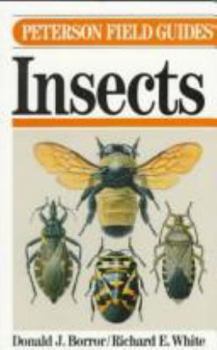Field Gde T/Insects of America North of Mexico
(Book #19 in the Peterson Field Guides Series)
Select Format
Select Condition 
Book Overview
Find what you're looking for with Peterson Field Guides --their field-tested visual identification system is designed to help you differentiate thousands of unique species accurately every time.... This description may be from another edition of this product.
Format:Paperback
Language:English
ISBN:0395185238
ISBN13:9780395185230
Release Date:January 1974
Publisher:Houghton Mifflin
Length:416 Pages
Weight:0.87 lbs.
Dimensions:0.9" x 4.5" x 7.2"
Customer Reviews
6 ratings
Good for references for art
Published by May , 1 year ago
This is about 50/50 text and pictures which is great for reference material for art!
A Good Place to Start with Insect Identification
Published by Thriftbooks.com User , 17 years ago
This is a good field guide to have on hand to get a general identification of an insect. The illustrations are large, clear drawings with a center section of ones in color. Just today I was amazed to spot a five-inch walkingstick. With a quick flip through the book, I matched it with the general shape of the insect. The book told me the family name and gave a general description. With that info, I was able to do an internet search on Phasmatida + Florida + photo. That led me to the exact insect and several articles about its behavior, food, and other useful information.
The best field guide to North American insects
Published by Thriftbooks.com User , 18 years ago
"In this century," according to ecologist Paul R. Ehrlich, "no one has done more to promote an interest in living creatures than Roger Tory Peterson, the inventor of the modern field guide." Peterson's "Guide to the Birds" - "the first modern field guide" - was published in 1934. Its pioneering approach was to use visual characteristics rather than technical data to identify species. This was achieved by grouping similar species together on a plate, using clear, two-dimensional illustrations, and pointers to key field marks as well as succinct text, a combination known as the Peterson Identification System. That revolutionary style was later applied to a host of field guides covering anything from the night sky to moths and geology to mushrooms and including the present volume. Here we have Number 19 in the Peterson Field Guide Series, published in 1970 and still in the original edition. Borror, an entomologist and well-known sound-recordist, is the author and contributed line-drawings. The main illustrations, in colour and monochrome, are by Richard White. With over 90,000 species of insects in America north of Mexico, a field guide to the insects must choose between being highly selective or else providing an overview to enable the user to identify major taxonomic groups. This guide achieves the latter aim admirably, allowing the reader to identify most insects to family level for 579 families. Apart from the systematic text, there are introductory chapters on collecting insects, studying live insects and basic insect biology as well as a handy Glossary. Because of the mammoth diversity of insects, a single volume work cannot be expected to allow the reader to identify insects to species by using colour plates. Indeed, many insects are simply not identifiable without a specimen. So, by the very nature of the subject matter, this may not be a book to be used by the unprepared casual observer. However, serious amateur naturalists have for decades enjoyed it as an invaluable aid to insect identification. Indispensable!
In-depth is an insufficient description for this book.
Published by Thriftbooks.com User , 20 years ago
Most who use this book have the same general complaint -- no color. Color, however, can be one of the most useless characteristics in identifying insects (especially if there are multiple color morphs).Since this is not a guide which was designed to identify every insect species within a given range (which is impossible within the scope of a single tome), it does its job well...and that job is to help narrow the possibilities of identifications for each individual insect. There are specialist books for more specific (excuse the pun) identifications. This book may be used to point toward the specialist books necessary for correct identifications and should be used in that fashion.There is a lot to be learned from Richard E. White's book, and reading the book from cover to cover is recommended for every insectophile. That's why, in spite of the inability to correctly identify even every insect in my backyard, I give this book 5/5.
Most Used Insect ID Book
Published by Thriftbooks.com User , 23 years ago
I have used this book for years. It is great for quick and easy insect identification. Good for the entomologist as well as the layman. Few color illustrations (lots of B & W) but since insects are very rarely identified by color, this is practically irrelevant. Highly recommended.
great book
Published by Thriftbooks.com User , 25 years ago
This book is the most comprehensive general field guide to insects available. It has both good pictures and text that can help the amateur identify insects down to the family and occasionally down to genus and species.




